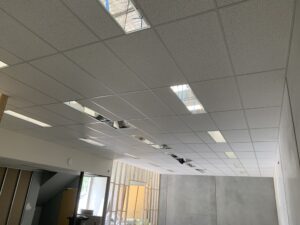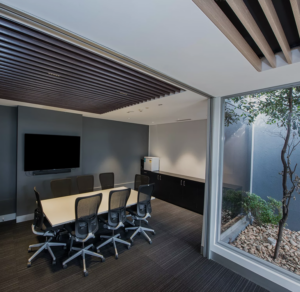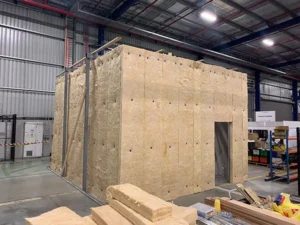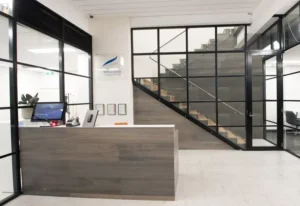Guide to Health & Safety in the Office
If you’re a business owner with an office space, you probably know how important workplace health and safety (WHS) are in Australia. WHS policies and practices are expected from all commercial spaces to ensure the physical and the mental well being of employees.
This can include ergonomic workstations, fire safety measures, hygiene and mental health even. Prioritising a safe office environment can minimise the risk of accidents and injuries in the office benefiting both the business and its staff.
With this guide, you can learn more about how to comply with office health and safety requirements especially when opting for office fit outs or renovation projects.
Importance of Office Health & Safety
As an office owner or manager, you are responsible for ensuring safety and health in the office space by encouraging a culture of safety from top to bottom. This safety culture is not just a legal requirement, but also morally important.
By promoting worker safety, you reduce the risk of accidents and work-related injuries. This in turn keeps employees feeling valued and productive, reduces absenteeism and also keeps a check on compensation payments.
Safe Work Australia’s WHS numbers show an average of 8 weeks are lost in time off from work related illness and injury, with $15, 743 paid in workers compensation. By incorporating health and safety in your office space, you are proactively protecting your employees and yourself from both health-related and financial losses.
Another plus point?
Your commitment to WHS may get you a boost in reputation, making it easy to attract potential employees and impress other stakeholders.
Health & Safety Hazards in the Office
Occupational hazards are risks or dangers that result from a particular work environment or job. When working on WHS implementation in the office, it is important to know what hazards are present in your workplace and how they can impact employee health and safety. Common hazards in a workplace can include:
- Physical hazards: Slips, trips and falls (due to wet floors, uneven surfaces or poor lighting), loud noises, poor ventilation and temperature control
- Ergonomic hazards: Poor workstation design and repetitive movements that may lead to musculoskeletal disorders.
- Electrical & Fire Hazards: Risk of electrocution from faulty or exposed wiring or fires from improper handling of flammable substances.
- Biological & Chemical Hazards: These can include exposure to bacteria, viruses, and mould due poor office hygiene or ventilation. Using irritants and chemical agents that are harmful to employees can also pose health related issues.
- Psychosocial hazards: You may also see psychological hazards in the workplace arising from stressful work environments, excessive workload or harassment.
Of course, lots of occupational hazards will depend on the type of industry you are operating in. Even though chances of injury from operating machinery or carrying heavy loads may be higher in a manufacturing company or a warehouse, you could expect eye strains, muscular sprains and stress induced illnesses from repetitive desk jobs.
Hazards in the office can also change if your office is undergoing a renovation or construction project without any downtime which can be dangerous for employees.
13 Office Work Safety Tips
Now that you’re aware of potential hazards that could arise in your office, let’s take a look at some actionable tips you can focus on to make sure it is safe for employees.
1. WHS Requirements
Your first course of action should be to acquaint yourself with the WHS laws you are required to follow and make sure your office meets those laws.
WHS policies in Australia are shaped by the Work Health & Safety Act of 2011 (WHS Act). It includes important work health and safety regulations and model WHS laws to guide companies and business owners. Victoria follows similar regulations that fall under their Occupational Health & Safety Act of 2004.
Depending on where your office is located, you will be adhering to WHS laws that are regulated by your respective state under these Acts. Key aspects of WHS policies usually include risk management, employee training, incident reporting and regular safety audits.
2. Office Safety Walkthroughs
Conducting risk assessments and identifying potential office hazards both require a thorough check of the office premises. The best way to do this is to conduct scheduled safety walkthroughs to keep an eye on any potential safety issues. Not only will these walkthroughs tell you what risks are present, but you can also evaluate your safety protocols and check if they are being followed.
While conducting this walkthrough, you or your team can observe employee workstations, lighting, emergency exits, wet floors and office cleanliness to name a few elements. This proactive approach can help keep a safe environment for employees by tackling issues before they lead to accidents or injuries.
To best do this, your office can appoint safety offices or WHS coordinators to carry out these checks in line with an office safety checklist.
3. Safety Reporting
WHS policies require incident reporting to make sure risks are managed timely and chances of future safety incidents are reduced. As a business owner, you may have to build a culture of free-flowing communication in the office space, encouraging employees to report unsafe working conditions as they arise and take immediate action.
With timely safety reporting, offices will have a detailed account of the safety incident, helping them to identify the cause and take corrective measures. Safety reporting also needs to comply with WHS laws, especially when it comes to reporting timelines. More severe injuries or fatalities may need to be reported within 24 hours.
4. Staff Training
To build any organisational culture, training and educating staff is crucial. By including employees in your office safety guidelines, the responsibility for ensuring a safe work environment can be shared by everyone working in the office.
Empowering your employees with health and safety rules and responsibilities can make them feel more valued and better ensure safety standards. Employees can then timely identify hazards and report them.
In addition to an initial training for new hires or for new policies, annual or 6 monthly refreshers can reinforce WHS guidelines and address employee concerns. These trainings are also an ideal time to touch base on emergency protocols and incident reporting procedures.
5. Ergonomic Office Design
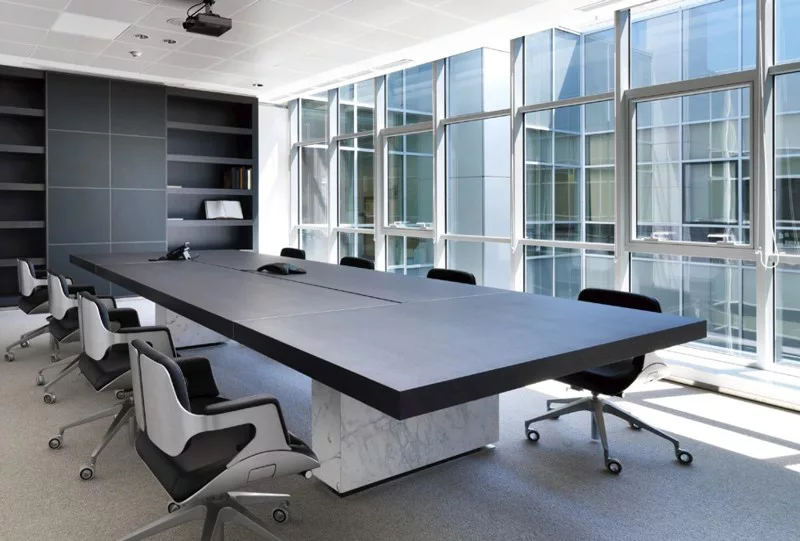
Office ergonomics may be important for maintaining employee health and safety in more ways than you think. An ergonomic workstation with adjustable desks, chairs and monitors can prevent back pain, neck strains and carpal tunnel syndrome. Ergonomic lighting, with plenty of natural light may not only reduce eye strain but be a great mood uplifter for employees.
Additional elements like footrests and head rests can further make employees comfortable when working long desk jobs. If you’re concerned about your office ergonomics, an office fit out expert can evaluate your office space and provide customised ergonomic solutions that best help your employees.
On top of that, an ergonomic office layout with spaced out offices and cubicles can help to maintain ventilation and temperature, which can be especially useful when designing small offices.
6. Accessibility
When designing an office space, business owners and property managers need to make sure it is usable by all employees, including those with disabilities. This includes both accessibility and safety aspects.
WHS policies in the office should promote inclusivity where differently abled employees are safe from accidents and health risks. A few ways to make an office accessible include:
- Entrances and Exits: Wheelchair accessible entrances and exits with ramps and automatic doors where necessary. Clear, easy to read signage and well-lit paths are also important for accessibility.
- Workstations: Adjustable desks and chairs to accommodate various physical needs and sufficient space in the office layout for easy manoeuvrability of mobility aids.
- Restrooms: Accessible restrooms should be equipped with grab bars, lower sinks, and ample space for wheelchairs.
- Parking: Designated and spacious parking spaces close to building entrances for individuals with disabilities
- Technology and Communication: Assistive technologies such as screen readers and voice recognition software.
7. Emergency Procedures
Emergency preparedness in the office helps to reduce risk of damage to property and injury to employees. An office with WHS policies in place will also have detailed emergency protocols to follow that their employees are frequently trained on.
Designing an office space with emergency procedures can include:
- Evacuation Routes and Exits: Easily accessible primary exits, secondary exits, and evacuation routes. These should be clearly marked and be wide enough to allow escape for all employees.
- In-Office Shelters: Designing safe areas within the office where employees can take shelter in the event where evacuation is not possible e.g. due to severe weather or poor law and order situations.
- Accessible Emergency Equipment: An office space well prepared for emergencies will also have safety equipment cabinets and storage that are easily accessible by employees or trained professionals for dealing with certain emergencies e.g. fires.
8. Fire Safety
Fire safety procedures often fall in an office’s emergency protocols as they can pose a significant threat to people and property. To avoid loss of life and damage to office premises, implementing fire safety measures under WHS is important.
To stay fire safe, it should be a priority to follow office fire safety tips from the get-go. These include the use of firewalls and fire rated doors with high fire resistance for office spaces with a higher risk of fires.
Other measures for fire safety in an office could include designated and accessible locations for fire extinguishers, fire blankets and hose reels. When installing an office suspended ceiling, special care must be taken to ensure functioning sprinkler systems, fire alarms and emergency lighting in accordance with Australian Standards.
Make sure to hire an expert office fit out company that prioritises fire safety in all construction and office renovation projects with use of fire-resistant materials where needed.
9. Safe Handling Procedures
Safe handling procedures are crucial to WHS regulations. They are the rules set in place for moving, transporting and managing materials and equipment to reduce chance of injury or damage.
While they play a very important role in factories and warehouses where tasks often involve heavy lifting, they can also be implemented in office environments where moving office furniture, and managing other office supplies is required.
Other industries where safe handling procedures must be incorporated include manufacturing, logistics, healthcare, chemical, food and even retail.
10. Fall Prevention Measures
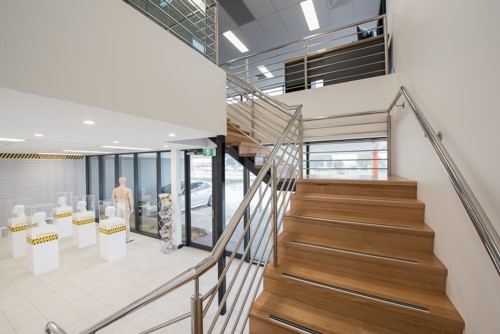
Even offices requiring limited physical exertion can be the site for slips, trips and falls. Seemingly commonplace, these can result in serious injuries that impact employee health and productivity and can become a financial liability for the office.
To prevent falls, your office fit out project may need to consider the following aspects:
- Non-Slip Flooring: These could include non-slip mats or materials in areas prone to spills, such as kitchens and bathrooms.
- Proper Lighting: Well-lit workstations, corridors and staircases
- Cords and Wires: Cable management systems to keep wires organised and out of walkways to avoid them becoming tripping hazards. Not just this but managing exposed wiring is also important for office electrical safety
- Stair Safety: Handrails on all staircases, non-slip treads and clearly marked edges of each step.
- Furniture Arrangement: Arrange furniture with safety in mind so it does not obstruct walkways and provides a clear path
In addition, making sure the office is clean and clutter free can reduce chances of employees tripping over things, while cleaning up spills immediately can prevent slips and ensure a safer working environment.
The risk of falls may be higher when an office is undergoing construction. Here it is important to follow workplace construction safety tips such as signage and request office downtime where needed.
11. Office Hygiene
What makes office hygiene important? It simply prevents the spread of illnesses, improving employee productivity and reducing sick leaves.
What makes office hygiene important? It simply prevents the spread of illnesses, improving employee productivity and reducing sick leaves.
Regular cleaning of workstations, kitchens, bathrooms and other common areas in the office is important to maintain cleanliness. In addition, setting up sanitization stations with hand sanitizers placed at important locations can control the spread of germs.
From an office fit out point of view, hygiene can be maintained by proper waste management systems with designated bin areas away from employee workstations to prevent odours and pest issues. Air quality also plays an important part here, and a well ventilated office interior design focused on spaced out cubicles, aircons and plants can help make an office a healthier place for employees.
12. Office Soundproofing

Loud and distracting noise in an office can impact employee well-being and productivity. Constant exposure to high noise levels not only make a work environment stressful, but also are a health risk with potential long term hearing damage.
Implementing office soundproofing solutions can help quiet down concentration intensive office spaces where employees need to focus. These can include use of acoustic panels, soundproof glass walls or some sound absorbing upholstery.
In addition, an office space can have specific quiet zones for employees to take a break from excessive noise.
Where loud factories and manufacturing sites are concerned, soundproofing may need to be done at an industrial level to prevent hearing loss and can require multiple soundproofing measures as well as personal protective equipment (PPE) to be used.
Make sure to consult with your fit-out contractors to develop tailored soundproofing strategies that meet the specific needs of your workplace.
13. Breaks and Recreation
It is important for any business to encourage timely breaks for employees to unwind and manage work related stress. Breaks also help manage the risks related to repetitive motion injuries e.g. strains caused by typing or operating machinery.
When designing your office space, make sure to incorporate dedicated spaces for recreation. These can include cafeterias, lounges, green outdoor spaces and even gyms. Reinforcing the need for employees to use these spaces throughout the work day can make your office more productive and minimise work related injury risks at the same time.
Prioritise Workplace Health & Safety
Your workplace and the employees you hire are a key part of your business so making sure the health and safety requirements of your office and staff are properly met is just as important as any other function.
By following WHS regulations and guidelines in your office fit outs, renovations and day to day operations, you can minimise the health and safety hazards and ensure a comfortable and productive work environment.
Reach out to us at Metro Office Fit Outs to help you design a WHS compliant commercial fit out.

